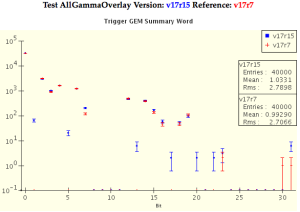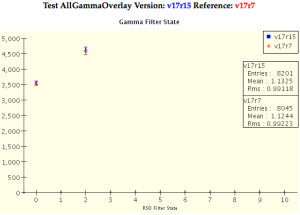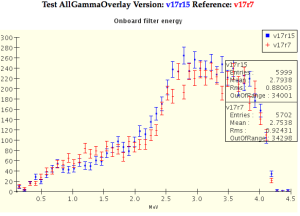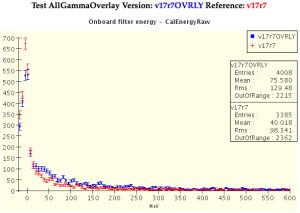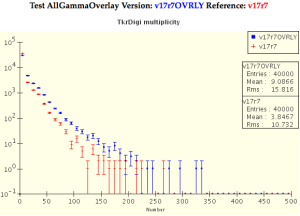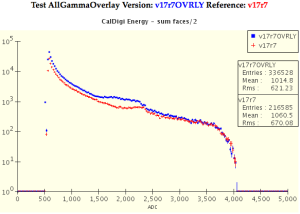I have added a new system test to provide feedback on overlay simulations.
This page summarizes details of the test and initial release comparisons.
Please comment below to recommend changes and additions. See the suggested new histogram list.
Overlay System Test Configuration
As a starting point, the overlay test (AllGammaOverlay) is run exactly like the system test AllGamma sample with the following additions:
- default overlay job options are included,
#include "$OVERLAYROOT/src/MergeAlgs/Overlay.txt";
- overlay XML input location is specified,
OverlayInputSvc.InputXmlFilePath = "path_to_Leon's_latest_overlay_files_I_hope";
- RootIo option to avoid memory leak,
RootIoSvc.RebuildIndex = false;
- orbit inclination set (same used for all gamma validation runs)
FluxSvc.OrbitInclination = 25.8;
The overlay input files are selected by setting an environment variable.
The overlay event format changes a bit with the releases, meaning the XML location and Overlay_path are currently updated by hand to match the desired GR version (this is fraught with peril and I have already screwed it up once). Here is what I am using.
Overlay_path= GR v17r7: /nfs/farm/g/glast/u31/lsrea/McIlwainL/5-Feb-2009/ GR v17r10 - GR v17r13: /nfs/farm/g/glast/u31/lsrea/McIlwainL/18-Mar-2009/ GR v17r14 - ?: /nfs/farm/g/glast/u18/Reprocess-tasks/Overlay-maker3/binnedData/
See the note below about the general system test job options.
The AllGammaOverlay test produces the same output histograms as AllGamma for now. Probably some things should be added. My short list is below.
Overlay Comparisons
First, is to do a baseline comparison of the overlay and non-overlay versions. I rigged a direct comparison through the systest interface for GR v17r7.
The GR v17r7 run shows the AllGammaOverlay test with the overlays disabled (exactly the same as normal AllGamma). The run GR v17r7OVRLY has overlays turned on. This allows an easy comparison of AllGamma against AllGammaOverlay.
See the failed plots. (Should be comparison of v17r7OVRLY against v17r7 for AllGammaOverlayTest). The AllGamma histograms have not changed for v17r7 up to v17r15. You can do the same trick to compare the later overlay tests with the normal AllGamma test using the v17r7 AllGammaOverlay version.
One thing I am trying to confirm is that the overlay test is working properly and as desired. For example, is it okay to run these with ideal calibrations? Seems like, yes. Any other configuration issues?
In general, there are more digis and less 0's for all the subsystems. This evolves a bit with the later GR versions. Energy features are shifted a bit higher in some distributions. There are more triggers and more vetoes. These are not surprises. Examples below.
Noisy Strips
comparison of two overlay versions |
||
no overlay version |
There are very noticeable outliers in the TkrDigiLayer and TkrDigiTower plots. I'm not sure what should be special in the overlays for Layers 7 and 17 or Towers 0 and 8? Calibration mismatch? The overlays are derived from data, but the system tests use ideal calibrations. (Nope. From Leon: the overlay events are type 0, where the specific calibration info is removed.)
You may have already guessed... these are hot tracker strips in the PT (periodic trigger) events. The selected periodic trigger events must be taken from before some of the hot strip mask updates were made. See this presentation on Tracker Status at the September 2008 collaboration meeting. The two layers outside specification at that time were Tower 0 X7 (32 strips) and Tower 8 X17.
This level of noise, although very noticeable in the digi plots, does not have much effect on the track reconstruction.
Selected plots from the initial comparison of GR v17r7 with and without overlays turned on.
Note that the system tests pass all events, and there is no filtering or trigger criteria applied to the digi distributions.
v17r7 overlay vs no overlay |
v17r15 vs no overlay |
|---|---|
|
|
|
|
|
|
|
|
|
|
|
|
|
|
|
|
|
|
|
|
|
|
|
|
The overall level of digis is reduced for the later GR versions compared to v17r7. I think some of this for the ACD should be because of the updates to exclude sub-threshold ACD tiles for PT events. The ACD hit status bits were added to ACDOverlay in v17r10.
A change in v17r13 is the handling of merging overlays into empty events, pure overlays. This should reduce the general level of digis.
Additional Overlay tests?
A secondary item is if the AllGammaOverlay test is sufficient at the system test level. Do we want additional tests for specific energies or maybe magnetic latitudes?
Miscellanea
System Test Job Options
The system tests (circa GR v17rX) are run using the standard Gleam job options, $GLEAMROOT/src/basicOptions.txt, with only one notable addition:
- TriggerAlg.applyPrescales = false
The system tests do not pick up calibrations from the database. They default to ideal calibrations, i.e. calibration flavor = "ideal".
Another item of note: The default Geant 4 physics model in the basic options is "GLAST". The preferred model is now QGSP_BERT, which includes the updated LPM effect.
Suggested New Histograms for Overlay Test
I picked out some items based on new merit ghost/overlay variables. Please add other parameters of interest (or even better, code).
- Ghosts in the Tracker
- TkrNumGhosts
- TkrNumToT255s
- TkrNumWideClusters
- TkrNumWiderClusters
- TkrNumGhostsOnTracks
- TkrNumToT255sOnTracks
- anything else?
- Overlay event info
- Overlay event trigger bits
- Overlay PtMcIlwainL (or PtLambda?)
- anything else?





